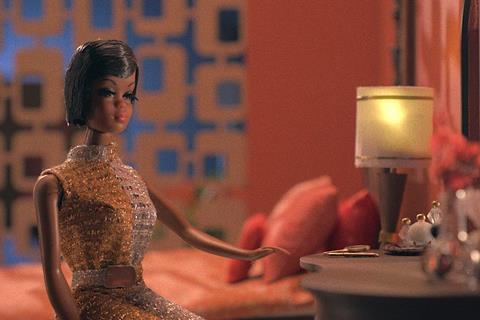Documentary explores America’s enduring race problem through the eyes of its most famous doll

Dir/scr: Lagueria Davis. US. 2023. 100mins
The Barbie doll has long been held up as the standard for conventional beauty — a damaging cultural impression that has left many young women feeling that they do not measure up. Lagueria Davis’ thoughtful documentary Black Barbie examines that fallout from a personal perspective, exploring how Black girls are harmed by not seeing themselves in Barbie’s blonde-haired, white-skinned prettiness — but also how the later introduction of a Black Barbie somewhat (but not entirely) helped repair their self-image. Using Davis’ own aunt, who worked for Mattel for 44 years, as its narrative through-line, the film can sometimes meander and is not always as rigorous a study as one might hope. Nevertheless, there’s no denying the endlessly troubling questions raised about identity, empowerment and systemic racism.
Who knew that a child’s toy could be such a fraught metaphor for societal ills?
Black Barbie premieres at SXSW, no doubt hoping to capitalise on this summer’s unveiling of the big-budget Margot Robbie comedy Barbie. Toy collectors and Barbie fans should be intrigued, as will those with an interest in how popular culture reflects societal values. Davis’ conversational tone ensures that her documentary debut is be an inviting proposition for prospective buyers.
In voiceover, Davis explains that she did not grow up loving dolls, despite having an aunt, Beulah Mae Mitchell, who was employed at Mattel from 1955 until 1999. The toy company, of course, is best known for Barbie, and the writer-director articulates her misgivings about this white doll to whom she could not relate. Davis was hardly alone in feeling this way, and Black Barbie traces the history of the first Barbie doll that was Black (but was given another name) — and then, afterward, the creation of an actual Black Barbie, which hit shelves in 1980, 21 years after the white original.
The film incorporates a wealth of talking heads (including Kitty Black Perkins, who was instrumental in designing the 1980 Black Barbie) to offer a chorus of Black voices analysing how Barbie has influenced fashion and beauty — often leaving Black girls wondering why they are not considered beautiful, too. Davis’ decision to build Black Barbie around the evolution of her own thinking on dolls is only moderately successful, but is mitigated by her regular ceding of the spotlight to her guests, who range from historians to celebrities to the director of diversity, equity and inclusion at Mattel.
One of Black Barbie’s strongest elements is its careful examination of Barbie’s rise and the attempts within the company to manufacture a Black doll. Initially, that doll was, essentially, just a traditional Barbie with a darker skin tone, prompting Perkins to retool the toy so that it more accurately reflected Black physiology and culture. (In the documentary, Perkins reveals that Diana Ross was her model for the doll.)
Yet Davis illustrates how one step forward in terms of representation was often met with a corresponding step back. Notably, Mattel failed to market its Black Barbie with the same gusto as her white counterpart — several of Davis’ subjects admit that they weren’t even aware of a Black Barbie growing up. The company’s strategy wasn’t necessarily malicious, but it nonetheless speaks to how whiteness is positioned as the norm, with Mattel’s Black dolls frequently depicted as Barbie’s best friend in advertising and films. As several of Black Barbie’s contributors note, how can Black girls feel like the main characters in their own lives if the doll that looks like them is always the sidekick?
The documentary’s breezy tone can sometimes be a detriment, resulting in a film that frequently settles for warm conversations instead of deeper scrutiny. Davis’ casual, intimate approach has its rewards, however, creating safe spaces for people to talk about Barbie and, also, themselves. (Tears are shed on occasion as subjects recall the racism they have endured.) And Black Barbie offers sobering sequences, such as when Davis echoes a 1940 scientific study — in which children of different races identified a Black doll as being inferior to a white one — with a recent study, the results slightly more encouraging but still demonstrating how people of colour are negatively perceived in society.
Throughout, Mitchel talks about her time at Mattel, an experience she considers resoundingly positive. And Davis does her due diligence, speaking to Mattel’s diversity director, as well as a writer who worked on a Barbie video project, to learn how the company is trying to be more mindful in its approach to representation. Still, Black Barbie underlines how so many of America’s problems with racial inequality stem from a gap between good intentions and measurable change. Who knew that a child’s toy could be such a fraught metaphor for societal ills? Sadly, many Black girls and women have been aware all along — Davis’ modest film is a step to making those inequities more visible.
Production companies: LinLay Productions, Just A Rebel, Lovely Day, Lady & Bird Films
International sales: Submarine, info@submarine.com
Producers: Aaliyah Williams, Lagueria Davis
Cinematography: Sara Garth
Editing: Heidi Zimmerman
Music: Esin Aydingoz























